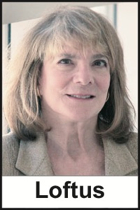Dec. 5, 2011
In this (Nov. 29) New York Times analysis of science’s ever-growing skepticism about eyewitness testimony I noticed a familiar name:
 “One of the earliest and more famous experiments to demonstrate that memories are malleable was conducted by Elizabeth Loftus, a psychology professor at the University of California, Irvine, and an early pioneer of witness memory research.
“One of the earliest and more famous experiments to demonstrate that memories are malleable was conducted by Elizabeth Loftus, a psychology professor at the University of California, Irvine, and an early pioneer of witness memory research.
“In a 1974 study published in The Journal of Verbal Learning and Verbal Behavior, (Loftus) asked participants to view films of fender-benders in which no car windows or headlights were broken. Later, the subjects who were asked how fast the cars were going when they ‘smashed’ into each other – as opposed to ‘hit’ – were more likely to report speeding and describe shattered glass they never actually saw.”
While researching a book on the Wenatchee, Washington, ritual sex abuse case (1994-95), Kathryn Lyon asked Loftus about the consequences when professionals contribute to and reinforce false memories in children.
“If you believe real child abuse has long-term deleterious consequences,” Loftus responded, “then what happens when you create a false memory of child abuse? Are you creating a victim who is also likely to have long-term troubles?
“Having a real and a pseudo memory are in many ways the same. If you create the memory, are you not creating child abuse?”
Lyon, a lawyer, spent a year in Wenatchee to write the thorough and chilling “Witch Hunt: A True Story of Social Hysteria and Abused Justice” (1998).
